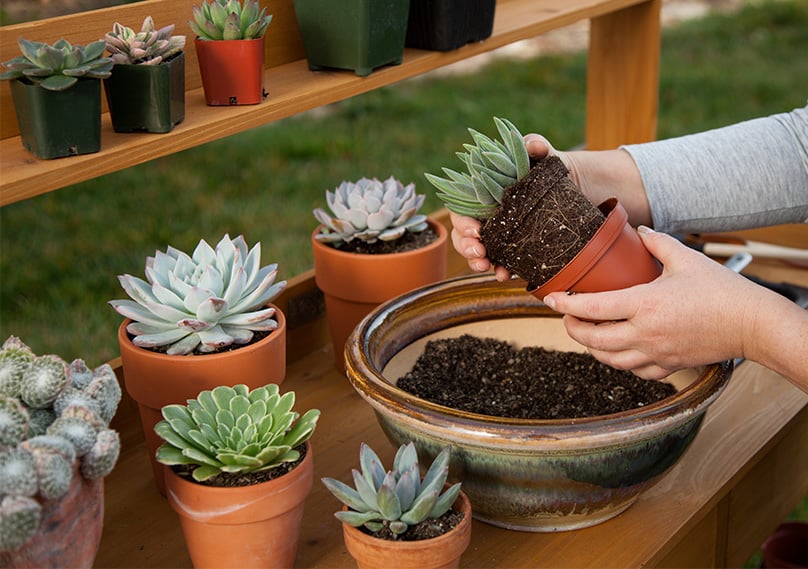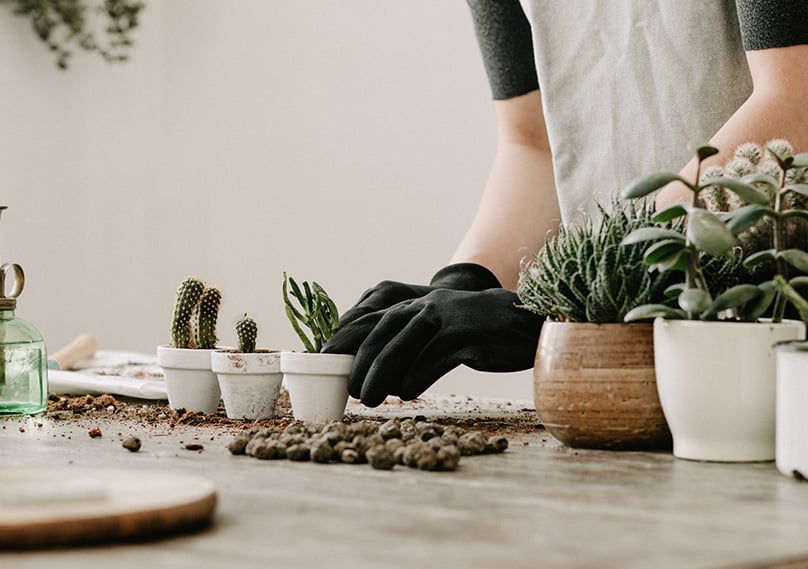Looking for a plant that’s both beautiful and easy to care for? If so, then succulents are for you! These hardy, drought-tolerant plants come in a wide variety of colors, shapes, and size; what’s more, they’re super easy to take care of. Even if you have a “brown” thumb, you can grow a beautiful garden with succulents.
While these robust plants are a lot easier to care for than more delicate flora, in order to flourish, they do need to be given a proper start and require some degree of care.
Whether you’re looking to plant them outdoors or indoors, in this guide, you’ll find some basic tips that you can use to plant a healthy and vibrant display.

Here is our recommended online shops for purchasing succulents & supplies
 Succulents Box
Succulents BoxSucculents Box currently offers more than 200 varieties of succulents (both popular and rare ones) along with 5 monthly subscription boxes.
Visit Store Leaf & Clay
Leaf & ClayLeaf & Clay offer a range of hundreds of types of succulents along with subscription boxes, pots & macrame.
Visit Store Lula’s Garden
Lula’s GardenLula’s Garden offers a selection of succulent garden gift sets from small single succulents in pots to full succulent gardens.
Visit Store The Succulent Source
The Succulent SourceThe Succulent Source offers a huge selection of succulents, cactii and also gift sets and items for weddings.
Visit Store Planet Desert
Planet DesertPlanet Desert cater to succulent and cactii fans with a large range of plants, soil, kits and other supplies for creating your garden.
Visit Store

Different Types of Succulents
We love succulents here at GardenBeast and have been putting together guides for different types, as follows:
- Guide to Succulents
- Aloe Vera
- Jade Plants
- Snake Plants
- Echeveria elegans
- Lithops
- Sedum Morganianum
- Coral Cactus
- Pleiospilos Nelii
- Portulacaria Afra
- Kalanchoe Tomentosa
- Sedum Rubrotinctum
- Kalanchoe Luciae
- Aeonium
- Orostachys Iwarenge
- Senecio Rowleyanus
- Stonecrop Sedums
Before You Get Started
Before you start planting succulents, the first thing you need to do is figure out where you want them to live: outside or in. Succulents do well in arid conditions and can flourish both in containers indoors or out, or in the ground. Here’s a look at some important things you should know about choosing a location to plant your succulents.
Container Planting
Succulents can do very well in containers and can make a beautiful indoor garden. If you’re planning on planting your succulents inside, make sure that you choose a location that’s warm, dry, and offers plenty of light; an area that mimics their natural habitat (dessert-like locations).

We love these Ceramic Planter Pots from Amazon
Do note, however, that while succulents need a lot of light, they shouldn’t be placed in direct sunlight for prolonged periods of time. Though they like hot temperatures and light, when they’re exposed to excessive amounts of direct sunlight, they can actually get sunburnt and spotty.
With that said, an windowsill or another area in your home that receives plenty of sun, but not too many hours of direct sunlight, would be the ideal placement for indoor succulents.
In-the-Ground Outdoor Planting
Outdoors, succulents do best when they’re planted in warm, arid climates. While these hardy plants can sustain cool temperatures (as temps can drop pretty substantially at night in the dessert), few species can tolerate near-freezing or sub-freezing temperatures; therefore, if you live in a location where the temperatures are consistently cold for prolonged periods of time, you should avoid planting succulents outdoors.

If you live in a location where the temperatures is warm year-round and your planting outdoors, the ideal spot is one that receives partial sunlight and partial shade. In other words, an area that receives a few hours of direct sunlight a day.
If the temperature fluctuates in your location (but doesn’t reach near-freezing or sub-freezing temperatures for prolonged periods of time) and you’re planting outdoors, a spot that receives ample amounts of sunlight to keep them warm is ideal; however, direct sunlight still isn’t ideal, as even in cooler climates, prolonged exposure to direct sunlight can burn succulents.
Planting Succulents in Containers
Whether outside or in, if you’re planting succulents in containers, you’ll need to gather the following supplies:
- Containers with drainage holes
- Specialty succulent soil, or you could make your substrate by mixing:
- 3 parts potting soil
- 2 parts course sand (turface works great)
- 1 part pumice or perlite
- A drainage screen or mesh tape
- A top dressing
- A shovel
- And of course, succulents
While most of the supplies on this list you’re probably familiar with, if you’re new to planting succulents, there are two items that you may not have heard of before: mesh tape/drainage screen and top dressing. Let’s take a look at these two items.

Succulent Planter Soil Kit from Amazon has all you need.
Mesh tape
Drainage is extremely important for succulents; however, soil tends to pour through the drainage hole, which not only makes a mess, but can impact the health of the plant. To prevent soil loss while still allowing proper drainage, place a piece of mesh tape or a drainage screen over the drainage hole in your container. It’s a simple, yet highly effective solution.
Top dressing
A top dressing is just decorative stones that’s placed over the top of the soil once the succulent has been planted. A top dressing adds to the look of the container, but it offers more than just aesthetics; it also serves practical purpose.

A top dressing helps to stop the soil from moving when you’re watering your succulent. This not only helps to ensure that the plant receives proper nutrients from the soil, but it also keeps the container looking neat and clean.
There are various types of materials that can be used as a top dressing. Some great options include small pieces of colorful granite, quartz, and glass beads. If you prefer, moss can be used as a substitute for rocks or beads., or you could use a combination of materials.
How to Plant Succulents in a Container
Once you’ve gathered your supplies, you’re ready to plant. To do so, use the following instructions:
- Prep the container by covering the drainage hole with a drainage screen or mesh tape
- Fill the container with soil
- Water the soil so that it’s completely soaked
- Dig a shallow hole in the center of the soil; succulents don’t like to have their roots buried too deep.
- Carefully remove the succulent from the container it came in and remove excess soil from around the roots. Often, nurseries plant succulents too deeply in soil, burying the roots. You want to remove enough soil so that the roots are exposed and can embed themselves in the soil in their new container.
- Fill in the soil around the base of the plants.
- Arrange the top dressing along the soil.
Once the succulent is planted in its new container, place it in the location you appointed. Remember that once the succulent is planted, you don’t need to water it frequently.
We suggest a “soak and dry” method. Water the succulent when the leaves appear shriveled, drenching the soil and then wait until the soil is completely dry and the leaves are again shriveled to water it again.
Do note, when watering your container succulents that are placed indoors, avoid getting the tops of the leaves wet, as minimal air movement inside can cause the leaves to rot if they’re covered in water.

Planting Succulents Outdoors
If you’re going to plant your succulents outdoors, here’s a list of supplies you’ll need:
- A shovel
- Unless you live in an area that has naturally sandy soil, you’ll need a substrate to add to the soil; course sand, such as turface, is a great choice
- A top dressing
Succulents thrive in sandy soil, so if your soil isn’t sand-based, you’ll want to add a substrate to it. Doing so will help to improve drainage, thus improving the health of the succulent.
A top dressing, as mentioned above, refers to small pieces of rock that are placed over the top of the soil once the succulent has been planted. This not only adds to the aesthetic appeal of the plant, but it also prevents the soil from shifting during watering. If you’re planting outdoors in the ground, you can use larger pebbles or rocks that would be used for container planting; however, avoid using a top dressing that is too large.
How to Plant Succulents In-the-Ground Outdoors
To plant your succulents outdoors and in the ground, use the following steps:
- Dig a shallow hole in the location you have selected. Remember that succulents don’t like to have their roots buried too deeply under the ground.
- Mix substrate into the soil to improve drainage.
- Remove the succulent from the container it came in.
- Remove any excess soil around the roots of the container. Often, nurseries burry succulents too deeply in soil, which hides the roots. You’ll want to remove enough soil to expose at least the ends of the roots of the plant.
- Thoroughly water the hole prior to planting the succulent.
- Place the succulent in the hole.
- Cover the roots and base of the plant with soil, but avoid packing the soil too tightly, as it can prevent the roots from accessing water and establishing themselves in their new home.
- Arrange the top dressing on top of the soil around the base of the plant.
Once the succulent has been planted in the ground, let it sit for several days so that the roots can become acclimated to their new home. Keep a close eye on the plant, paying attention to the appearance of the leaves.
Once the leaves begin to look shriveled, it’s time to water the plant. Use a “soak and dry” method for watering. In their natural habitat, succulents receive large amounts of water on an infrequent basis; hence the reason why the “soak and dry” method is suggested for succulents that are planted in both containers and in gardens.

Summing It Up
Succulents make a wonderful addition to any indoor or outdoor plant display. They’re colorful, interesting, and best of all, they’re easy to care for. By using the above-mentioned tips, you can successfully plant succulents in containers or in the ground and enjoy the unique beauty that these plants provide.
